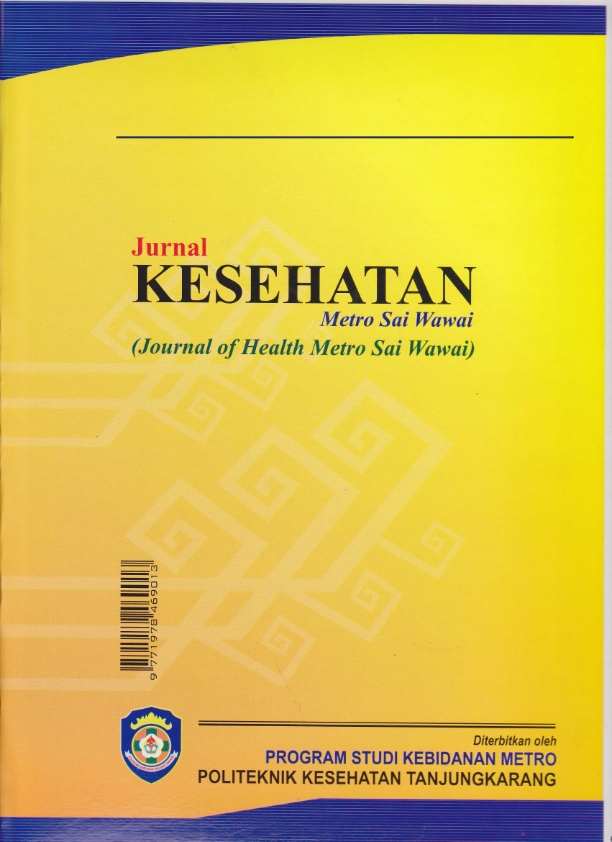The Effect of Education Using Video Learning Multimedia on Increasing Knowledge of Early Breastfeeding Initiation and Breastfeeding Techniques in Postpartum Sectio Caesarean Mothers at the Hospital
DOI:
https://doi.org/10.26630/jkmsaw.v17i1.4348Keywords:
Early breastfeeding initiation; knowledge; breastfeeding techniques; video learning multimedia.Abstract
Introduction: Excusive breastfeeding begins as early as possible from birth through the implementation of maternal compassionate care and join care. However, due to the impact of the COVID-19 pandemic, there is no joint care between babies and mothers after normal or section secaria deliveries in hospitals. It is important to increase knowledge of breastfeeding techniques to mothers, especially mothers giving birth by section secaria to prevent babies from not being breastfed early. Purpose: This study to evaluate the effect of education using video learning multimedia on increasing knowledge about breastfeeding and breastfeeding techniques in mothers who give birth sectio secaria. Methods: One group pretest posttest quasi experiment design was chosen as the research design. The study involved 58 participants selected using consecutive sampling technique. The treatment group was given an educational intervention on lactation management utilising multimedia videos that had been developed with eligible validity and reliability. Statistical analysis to test the hypothesis used the Wilcoxon test with a significance level (α) of 0.05. Results: A total of 57 out of 58 participants showed an increase in knowledge about breastfeeding and breastfeeding techniques with an average score of 67.97 (pretest) increasing to 82.34 (posttest). There was an effect on the level of knowledge before and after being given education using multimedia video learning media on participants (p=0,0001). Conclusion: The use of multimedia video learning media as education can improve knowledge about breastfeeding and breastfeeding techniques in postpartum SC mothers during the COVID-19 pandemic. Clinical midwives and health supervisors can utilise this media which is easy to use both online and offline for education, so that maternity mothers are motivated to carry out early breastfeeding of newborns to continue to provide exclusive breastfeeding.
Latar Belakang: Pemberian ASI ekskusif dimulai sedini mungkin sejak lahir melalui implementasi asuhan sayang ibu dan rawat gabung. Namun, dampak pandemi COVID-19 tidak dilakukan rawat gabung antara bayi dan ibu pasca bersalin normal maupun section secaria di rumah sakit. Pentingnya peningkatan pengetahuan teknik menyusui kepada ibu, khususnya ibu melahirkan secara section secaria untuk mencegah bayi tidak diberikan ASI sejak dini. Tujuan: Penelitian ini bertujuan mengevaluasi pengaruh edukasi menggunakan video learning multimedia terhadap peningkatan pengetahuan tentang pemberian ASI dan teknik menyusui pada ibu bersalin sectio secaria. Metode: Studi quasi experiment design one group pretest posttest dipilih sebagai rancangan penelitian. Penelitian melibatkan 58 partispan diseleksi menggunakan teknik consecutive sampling. Kelompok perlakuan diberikan intervensi edukasi menggunakan video multimedia dan yang telah diuji validitas dan reabilitasnya eligible. Analisis statistic untuk menguji hipotesis menggunakan wilcoxon test dengan tingkat kemaknaan (α) 0,05. Hasil: Sebanyak 98,28% dari 58 partisipan menunjukkan peningkatan pengetahuan mengenai pemberian ASI dan teknik menyusui dengan skor rata-rata 67,97 (pretest) meningkat menjadi 82,34 (posttest). Ada pengaruh level pengetahuan sebelum dan sesudah diberikan edukai menggunakan media video learning multimedia pada partisipan (p=0.0001). Simpulan: Pemanfaatan media video learning multimedia Sebagai edukasi mampu meningkatkan pengetahuan mengenai pemberian ASI dan teknik menyusui pada ibu pascabersalin SC pada masa pandemic COVID-19. Bidan klinik maupun Penyelia Kesehatan dapat memanfaatkan media ini yang mudah digunakan baik online maupun offline untuk edukasi, sehingga ibu bersalin termotivasi melaksanaan pemberian ASI dini pada bayi baru lahir hingga berlanjut memberikan ASI ekskluasif.
References
References
Adhisivam, B., Vishnu Bhat, B., Poorna, R., Thulasingam, M., Pournami, F., & Joy, R. (2017). Postnatal counseling on exclusive breastfeeding using video-experience from a tertiary care teaching hospital, south India. Journal of Maternal-Fetal and Neonatal Medicine. https://doi.org/10.1080/14767058.2016.1188379
Astuti, D. A., Susilawati, S., Sari, D. E. A., Sitanggang, T. W., Rini, A. V. P., Ratna, R., Nuriyana, N., Lisna, L., Marlina, R., & Putri, I. M. (2023). Promosi Kesehatan Untuk Bidan. https://repository.penerbiteureka.com/media/publications/563278-promosi-kesehatan-6776d.pdf
Cetinkaya Eren, O., Buker, N., Tonak, H. A., & Urguden, M. (2022). The effect of video-assisted discharge education after total hip replacement surgery: a randomized controlled study. Scientific Reports, 12(1), 3067. https://doi.org/10.1038/s41598-022-07146-y
Chen, C., Yan, Y., Gao, X., Xiang, S., He, Q., Zeng, G., Liu, S., Sha, T., & Li, L. (2018). Influences of cesarean delivery on breastfeeding practices and duration: a prospective cohort study. Journal of Human Lactation, 34(3), 526-534. https://doi.org/https://doi.org/10.1177/089033441774
Faridah, S. (2017). Perbedaan Pengetahuan Tehnik Menyusui Sebelum dan Sesudah Penyuluhan. Indonesian Journal for Health Sciences, 1(1), 17. https://doi.org/10.24269/ijhs.v1i1.386
Gomathi, B. (2014). Effect of video-assisted teaching program on management of breastfeeding problems. Nurs. J. India, 105, 149–151. https://www.tnaijournal-nji.com/admin/assets/article/pdf/10378_pdf.pdf
Imran, F. A., & Hasnah, H. (2017). Pengaruh penyuluhan kesehatan melalui media video terhadap peningkatan pengetahuan remaja putri tentang dampak abortus provokatus kriminalis di kelas X SMAN 2 Gowa. Jurnal Kesehatan, 10(2), 61–67. https://doi.org/https://doi.org/10.24252/kesehatan.v1i2.4385
Kusumastuti, I. (2018). Hubungan karakteristik ibu, paritas dan sumber informasi dengan pengetahuan ibu tentang tanda bahaya kehamilan. Jurnal Ilmiah Kebidanan Indonesia, 8(03), 124–132. https://doi.org/https://doi.org/10.33221/jiki.v8i03.158
Lian, W., Ding, J., Xiong, T., Liuding, J., & Nie, L. (2022). Determinants of delayed onset of lactogenesis II among women who delivered via Cesarean section at a tertiary hospital in China: a prospective cohort study. International Breastfeeding Journal, 17(1), 81. https://doi.org/https://doi.org/10.1186/s13006-022-00523-
Masitoh, S., Nurokhmah, S., Rizkianti, A., & Sugiharti, S. (2021). Hubungan Operasi Sesar dengan Inisiasi Menyusu Dini di Indonesia: Analisis Data SDKI 2017. Media Penelitian Dan Pengembangan Kesehatan, 39–50. https://doi.org/https://garuda.kemdikbud.go.id/documents/detail/1996731
Nasution, R. S., & Oktamianti, P. (2023a). Delay Early Initiation of Breastfeeding (EIBF) After Cesarean Delivery. Health Notions, 7(5), 129-136. https://doi.org/https://doi.org/10.33846/hn70505
Nasution, R. S., & Oktamianti, P. (2023b). Faktor Penghambat Keberhasilan Inisiasi Menyusu Dini (Imd) Pada Persalinan Sesar. Jurnal Cahaya Mandalika ISSN 2721-4796 (Online), 3(2), 686–696. https://doi.org/https://doi.org/10.36312/jcm.v3i2.1725
Nurak, C. E., Setiono, K. W., & Koamesah, S. M.. (2021). Efektivitas Media Video Terhadap Tingkat Pengetahuan Pemakaian Masker Kain Dalam Pencegahan Covid-19 Pada Mahasiswa Baru Universitas Nusa Cendana. Cendana Medical Journal (CMJ), 9(1), 30–37. https://doi.org/10.35508/cmj.v9i1.4932
Organization, W. H. (2019). Global breastfeeding scorecard, 2019: Increasing commitment to breastfeeding through funding and improved policies and programs. World Health Organization. https://iris.who.int/bitstream/handle/10665/326049/WHO-NMH-NHD-19.22-eng.pdf?sequence=1
Özdemir, F. K., Güngör, M. C. K., & Cici, A. M. (2023). Comparison of video-assisted education and traditional classroom education in pediatric cardiopulmonary resuscitation education of nursing students. Journal of Pediatric Nursing, 73, e388-e394. https://doi.org/https://doi.org/10.1016/j.pedn.2023.10.005
Pakpahan, M., Siregar, D., Susilawaty, A., Tasnim, T., Ramdany, R., Manurung, E. I., Sianturi, E., Tompunu, M. R. G., Sitanggang, Y. F., & Maisyarah, M. (2021). Promosi kesehatan dan perilaku kesehatan. Yayasan Kita Menulis.
PD IBI. (2021). Modul tatalaksana dan konseling menyusui bagi bidan klinik IBI. PD IBI Jakarta
Purwoko, M. (2018). Hubungan tingkat pendidikan dan pekerjaan dengan tingkat pengetahuan mengenai kanker ovarium pada wanita. Mutiara Medika: Jurnal Kedokteran Dan Kesehatan, 18(2), 45–48. https://doi.org/https://doi.org/10.18196/mm.180214
Rusyantia, A. (2019). Hubungan Teknik Menyusui dengan Keberhasilan Menyusui Pada Bayi Usia 0-6 Bulan yang Berkunjung ke Puskesmas Kedaton. Jurnal Kesehatan Holistik (The Journal of Holistic Healthcare), 11(2), 90–94. https://doi.org/10.33024/hjk.v11i2.121
Sroiwatana, S., & Puapornpong, P. (2018). Outcomes of video-assisted teaching for latching in postpartum women: a randomized controlled trial. Breastfeeding Medicine, 13(5), 366-370. https://doi.org/https://doi.org/10.1089/bfm.2018.004
Syabariyah , S., Hidayat, T. M., Sofiyah, Y., & Hisan, U. K. (2023). Audiovisual media effectiveness in post-cataract surgery care education in National Eye Center Cicendo Hospital. International Journal of Public Health, 12(4), 1736-1743. https://doi.org/10.11591/ijphs.v12i4.22814
Takahashi, K., Ganchimeg, T., Ota, E., Vogel, J. P., Souza, J. P., Laopaiboon, M., Castro, C. P., Jayaratne, K., Ortiz-Panozo, E., & Lumbiganon, P. (2017). Prevalence of early initiation of breastfeeding and determinants of delayed initiation of breastfeeding: secondary analysis of the WHO Global Survey. Scientific Reports, 7(1), 44868. https://doi.org/https://doi.org/10.1038/srep44868.
Ulfa, Y., Maruyama, N., Igarashi, Y., & Horiuchi, S. (2023). Early initiation of breastfeeding up to six months among mothers after cesarean section or vaginal birth: A scoping review. Heliyon, 9(6). https://www.cell.com/heliyon/fulltext/S2405-8440(23)03442-4
UNICEF, & WHO. (2018). Capture the moment: early initiation of breastfeeding: the best start for every newborn. United Nations Children's Fund. https://doi.org/https://www.unicef.org/eca/media/4256/file/Capture-the-moment-EIBF-report.pdf
Waryana, W., Sitasari, A., & Febritasanti, D. W. (2019). Intervensi media video berpengaruh pada pengetahuan dan sikap remaja putri dalam mencegah kurang energi kronik. AcTion: Aceh Nutrition Journal, 4(1), 58–62. https://doi.org/10.30867/action.v4i1.154
Wawan A, D. M. (2019). Teori dan pengukuran pengetahuan, sikap dan perilaku manusia. Nuha Medika.
Zhang, F., Cheng, J., Yan, S., Wu, H., & Bai, T. (2019). Early feeding behaviors and breastfeeding outcomes after cesarean section. Breastfeeding Medicine, 14(5), 325-333. https://doi.org/https://doi.org/10.1089/bfm.2018.015
Downloads
Published
Issue
Section
License
Copyright (c) 2024 Rizki, F & Novitasari, D. W.

This work is licensed under a Creative Commons Attribution-NonCommercial 4.0 International License.

Jurnal Kesehatan Metro Sai Wawai is licensed under a Creative Commons Attribution-NonCommercial 4.0 International License.






